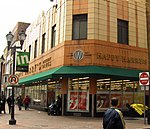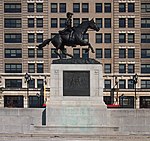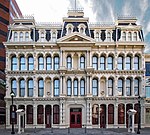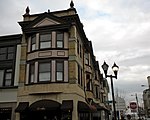Delaware Trust Building

Delaware Trust Building, now known as The Residences at Rodney Square, is a historic office building and bank headquarters located at Wilmington, New Castle County, Delaware. It was built in 1921, as a 13-story, 15-bay-by-15 bay, U-shaped steel-frame building in the Classical Revival style. The building has a watertable of gray granite, a limestone-clad two-story plus mezzanine base, and a shaft of buff-colored brick. Atop the building is a limestone cornice. The Market Street elevation features three monumental-scaled arched entrance openings reminiscent of ancient Roman buildings. It once had a 22-story modern office building at its center that has since been removed. The building has been converted to residential use. It was added to the National Register of Historic Places in 2003.
Excerpt from the Wikipedia article Delaware Trust Building (License: CC BY-SA 3.0, Authors, Images).Delaware Trust Building
North Market Street, Wilmington
Geographical coordinates (GPS) Address External links Nearby Places Show on map
Geographical coordinates (GPS)
| Latitude | Longitude |
|---|---|
| N 39.744814 ° | E -75.547763 ° |
Address
The Residences at Rodney Square
North Market Street 902
19801 Wilmington
Delaware, United States
Open on Google Maps









